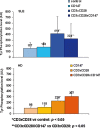Roles of CD147 on T lymphocytes activation and MMP-9 secretion in systemic lupus erythematosus
- PMID: 17488482
- PMCID: PMC3822832
- DOI: 10.1111/j.1582-4934.2007.00022.x
Roles of CD147 on T lymphocytes activation and MMP-9 secretion in systemic lupus erythematosus
Abstract
The cellular and molecular mechanisms involved in many abnormalities described in Systemic Lupus Erythematosus (SLE) are still unclear. Some of these abnormalities referred to the hyperactivation of T lymphocytes and the enhanced secretion of MMP-9 by peripheral blood mononuclear cells (PBMCs). Therefore, in this paper we investigated the potential role of CD147 molecule in these abnormalities. Our results demonstrated that CD147 molecule is overexpressed on CD3+T lymphocytes from SLE patients when compared with CD3+T lymphocytes from healthy donors. Monoclonal anti-CD147 antibodies, MEM-M6/1 clone, were able to inhibit protein tyrosine phosphorylation only in CD3 x CD28 costimulated T lymphocytes from SLE patients. However, this monoclonal antibody was unable to inhibit the enhanced activity of MMP-9 secreted by SLE PBMCs.
Figures








Similar articles
-
Matrix metalloproteinase-9 and its natural inhibitor TIMP-1 expressed or secreted by peripheral blood mononuclear cells from patients with systemic lupus erythematosus.J Autoimmun. 2003 Jun;20(4):323-31. doi: 10.1016/s0896-8411(03)00037-4. J Autoimmun. 2003. PMID: 12791318
-
CD69 to CD3 ratio of peripheral blood mononuclear cells as a marker to monitor systemic lupus erythematosus disease activity.Lupus. 1997;6(5):449-54. doi: 10.1177/096120339700600507. Lupus. 1997. PMID: 9229364
-
The spliceosomal autoantigen heterogeneous nuclear ribonucleoprotein A2 (hnRNP-A2) is a major T cell autoantigen in patients with systemic lupus erythematosus.Arthritis Res Ther. 2006;8(4):R118. doi: 10.1186/ar2007. Arthritis Res Ther. 2006. PMID: 16859514 Free PMC article.
-
Altered T and B lymphocyte signaling pathways in lupus.Autoimmun Rev. 2009 Jan;8(3):179-83. doi: 10.1016/j.autrev.2008.07.040. Epub 2008 Aug 20. Autoimmun Rev. 2009. PMID: 18721908 Review.
-
Circulating Matrix Metalloproteinase-9 Levels in Patients with Systemic Lupus Erythematosus: A Meta-analysis.Curr Pharm Des. 2018;24(16):1780-1787. doi: 10.2174/1381612824666180607123431. Curr Pharm Des. 2018. PMID: 29879882
Cited by
-
Targeting the chemotactic function of CD147 reduces collagen-induced arthritis.Immunology. 2009 Jan;126(1):55-62. doi: 10.1111/j.1365-2567.2008.02877.x. Epub 2008 Jun 14. Immunology. 2009. PMID: 18557953 Free PMC article.
-
The XX sex chromosome complement in mice is associated with increased spontaneous lupus compared with XY.Ann Rheum Dis. 2012 Aug;71(8):1418-22. doi: 10.1136/annrheumdis-2011-201246. Epub 2012 May 12. Ann Rheum Dis. 2012. PMID: 22580585 Free PMC article.
-
Zearalenone mycotoxin affects immune mediators, MAPK signalling molecules, nuclear receptors and genome-wide gene expression in pig spleen.PLoS One. 2015 May 26;10(5):e0127503. doi: 10.1371/journal.pone.0127503. eCollection 2015. PLoS One. 2015. PMID: 26011631 Free PMC article.
-
CD147 immunoglobulin superfamily receptor function and role in pathology.Exp Mol Pathol. 2007 Dec;83(3):283-95. doi: 10.1016/j.yexmp.2007.08.014. Epub 2007 Sep 7. Exp Mol Pathol. 2007. PMID: 17945211 Free PMC article. Review.
-
Matrix metalloproteinases in cytotoxic lymphocytes impact on tumour infiltration and immunomodulation.Cancer Microenviron. 2011 Dec;4(3):351-60. doi: 10.1007/s12307-010-0057-0. Epub 2010 Nov 27. Cancer Microenviron. 2011. PMID: 22161319 Free PMC article.
References
-
- Kammer GM, Perl A, Richardson BC, Tsokos GC. Abnormal T cell signal transduction in systemic lupus erythematosus. Arthritis Rheum. 2002;46:1139–54. - PubMed
-
- Blasini AM, Brundula V, Paris M, Rivas L, Salazar S, Stekman IL, Rodriguez MA. Protein tyrosine kinase activity in T lymphocytes from patients with systemic lupus erythematosus. J Autoimmun. 1998;11:387–93. - PubMed
-
- Matache C, Stefanescu M, Onu A, Tanaseanu S, Matei I, Frade R, Szegli G. p56lck activity and expression in peripheral blood lymphocytes from patients with systemic lupus erythematosus. Autoimmunity. 1999;29:111–20. - PubMed
-
- Nambiar MP, Enyedy EJ, Fisher CU, Krishnan S, Warke VG, Gilliland WR, Oglesby RJ, Tsokos GC. Abnormal expression of various molecular forms and distribution of T cell receptor zeta chain in patients with systemic lupus erythematosus. Arthritis Rheum. 2002;46:163–74. - PubMed
-
- Nambiar MP, Krishnan S, Warke VG, Tsokos GC. TCR zeta-chain abnormalities in human systemic lupus erythematosus. Methods Mol Med. 2004;102:49–72. - PubMed
Publication types
MeSH terms
Substances
LinkOut - more resources
Full Text Sources
Medical
Miscellaneous

